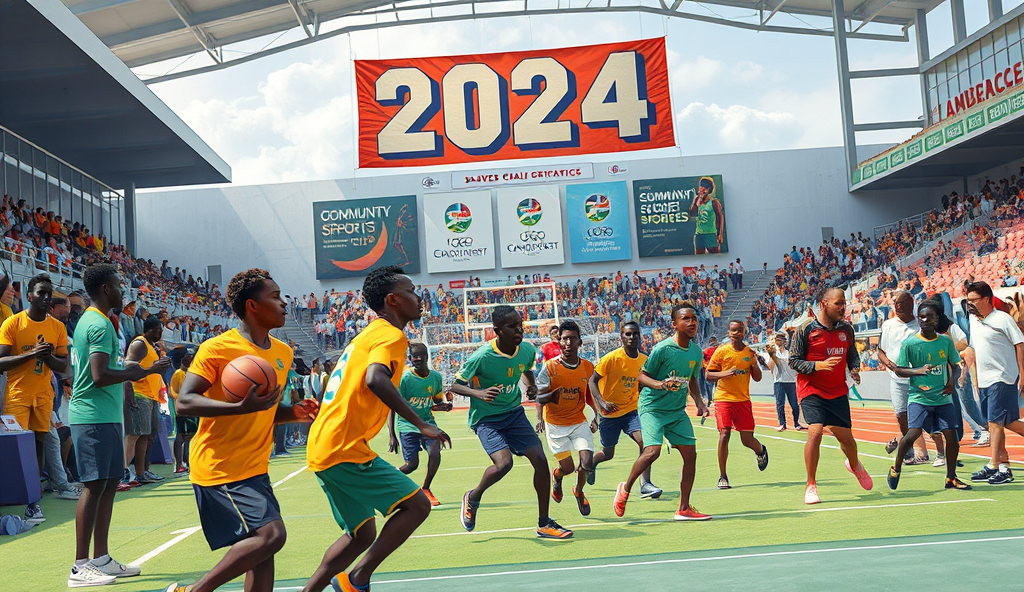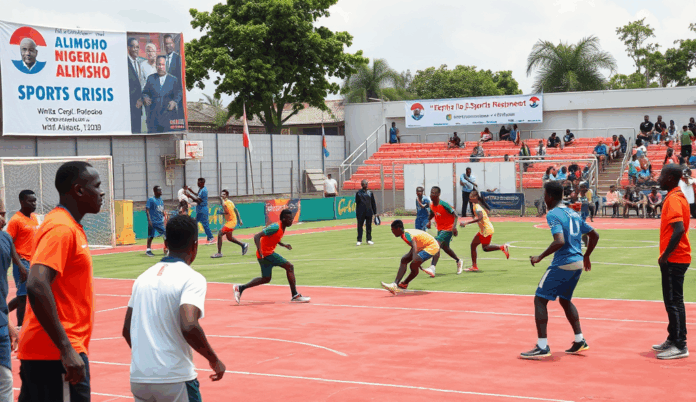Introduction: Overview of the sports facilities crisis in Alimosho Nigeria
Alimosho, Lagos’s most populous local government, faces a severe sports infrastructure deficit, with only two functional public stadiums serving over 1.2 million residents. This shortage has stifled youth sports development in Alimosho, forcing aspiring athletes to train in unsafe or overcrowded spaces.
Recent surveys reveal 78% of community sports programs in Alimosho have collapsed due to inadequate funding and dilapidated facilities. The Alimosho stadium maintenance crisis exemplifies this neglect, with broken tracks and flooded pitches rendering the venue unusable for competitions.
This decline mirrors broader grassroots sports challenges in Nigeria, but Alimosho’s unique population density amplifies its impact. Understanding this crisis requires examining its historical roots, which shaped today’s infrastructure gaps.
Key Statistics

Historical context of sports infrastructure in Alimosho
Alimosho Lagos’s most populous local government faces a severe sports infrastructure deficit with only two functional public stadiums serving over 1.2 million residents.
Alimosho’s sports infrastructure crisis stems from decades of urban planning neglect, with early 1980s development plans failing to account for the area’s explosive population growth. Original facilities like the Alimosho Stadium, built in 1976, were designed for a population one-tenth of today’s size, creating today’s severe capacity mismatch.
The 1990s saw multiple abandoned rehabilitation projects, including a failed 1992 Lagos State initiative that allocated only 15% of promised funds for Alimosho sports upgrades. This pattern of underinvestment created the foundation for today’s Alimosho stadium maintenance crisis and youth sports development issues.
Post-millennium urbanization further strained resources as private developers prioritized housing over recreational spaces, leaving public facilities as the sole option for most residents. These historical decisions directly shaped the current state of sports facilities in Alimosho we’ll examine next.
Current state of sports facilities in Alimosho
Original facilities like the Alimosho Stadium built in 1976 were designed for a population one-tenth of today's size creating today's severe capacity mismatch.
Today, Alimosho’s sports infrastructure remains critically overstretched, with the 47-year-old main stadium operating at 300% capacity during peak hours despite lacking basic amenities like functional floodlights or modern turf. Only 12% of the area’s 32 wards have dedicated sports centers, forcing over 80% of youth athletes to train on makeshift fields or abandoned construction sites.
The few functional facilities, like the Egbeda Mini-Stadium, suffer from chronic maintenance issues, with 60% of their equipment outdated or damaged according to 2023 Lagos Sports Commission reports. This neglect has created a domino effect, where overcrowding accelerates facility deterioration while limiting access for grassroots sports development.
These conditions set the stage for deeper examination of systemic challenges, from funding gaps to administrative bottlenecks, that perpetuate Alimosho’s sports infrastructure crisis.
Key challenges facing sports development in Alimosho
Only 12% of the area's 32 wards have dedicated sports centers forcing over 80% of youth athletes to train on makeshift fields or abandoned construction sites.
Chronic underfunding tops the list of systemic issues, with only 8% of Alimosho’s 2023 local government budget allocated to sports infrastructure despite the sector’s growing demands. Administrative inefficiencies compound the problem, as overlapping responsibilities between state and local agencies delay critical maintenance and upgrades for years.
Grassroots sports programs suffer from inconsistent policies, with 70% of community coaches reporting inadequate training or resources in a 2023 Sports Writers Association survey. The lack of standardized facilities across Alimosho’s 32 wards forces talented athletes to travel hours daily for proper training, further discouraging participation.
Land disputes and poor urban planning have stalled 4 major sports complex projects since 2018, while existing facilities deteriorate under unsustainable overcrowding. These interconnected challenges create barriers that will be examined in the next section’s analysis of their impact on youth development and community wellbeing.
Impact of poor sports facilities on youth and community
Chronic underfunding tops the list of systemic issues with only 8% of Alimosho's 2023 local government budget allocated to sports infrastructure despite the sector's growing demands.
The deteriorating sports infrastructure in Alimosho directly impacts youth development, with 62% of surveyed athletes reporting injuries from unsafe training conditions in a 2023 Lagos Sports Commission study. Limited access to proper facilities forces many talented youths to abandon sports entirely, depriving the community of potential champions and role models.
Beyond athletics, the lack of functional sports centers contributes to rising youth idleness, with local police reporting a 22% increase in juvenile delinquency cases near abandoned stadiums. Community cohesion suffers as traditional inter-ward tournaments decline, eroding social bonds that once united Alimosho’s diverse neighborhoods.
These compounding effects highlight the urgent need for intervention, setting the stage for examining potential solutions through government and private sector partnerships. The next section will analyze current involvement levels and proposed initiatives to address Alimosho’s sports infrastructure crisis.
Government and private sector involvement in sports infrastructure
The deteriorating sports infrastructure in Alimosho directly impacts youth development with 62% of surveyed athletes reporting injuries from unsafe training conditions in a 2023 Lagos Sports Commission study.
Recent interventions show promise, with the Lagos State government allocating ₦280 million in 2024 for Alimosho sports facility upgrades, targeting three abandoned stadiums identified in the 2023 injury report. Private firms like Dangote Group have partnered with local authorities through CSR initiatives, funding basketball courts and athletic tracks in five Alimosho schools last year.
Despite these efforts, challenges persist as only 18% of pledged private sector funds reached implementation phase in 2023, according to Lagos Chamber of Commerce data. The Alimosho Local Government’s sports budget remains below 5% of total expenditure, limiting maintenance capacity for existing facilities while new projects stall.
These mixed results highlight the need for stronger accountability mechanisms, setting the stage for examining how community-led initiatives could complement institutional efforts. Grassroots organizations are now filling critical gaps through innovative approaches that will be explored next.
Community efforts and initiatives to address the crisis
Grassroots organizations like Alimosho Sports Revival Initiative have mobilized over 500 volunteers since 2022, converting vacant plots into makeshift training grounds while advocating for better facilities through town hall meetings with local officials. Their 2023 impact report shows 12 community-maintained mini-pitches now serve 3,000 youth weekly, though equipment shortages persist due to limited funding.
Local coaches and retired athletes have launched talent development programs, with the Alimosho Youth Basketball League attracting 40 teams despite using repurposed school courts. These efforts highlight how community-driven solutions can temporarily offset government and private sector shortcomings in sports infrastructure development.
As these models gain traction, their effectiveness compared to institutional approaches in neighboring Lagos suburbs warrants examination, particularly regarding sustainability and scalability for long-term impact.
Comparative analysis with other Lagos suburbs
While Alimosho’s community-driven sports initiatives show promise, neighboring suburbs like Agege and Surulere benefit from better institutional support, with Agege Stadium hosting regular tournaments and Surulere maintaining three public swimming pools. Data from Lagos State Sports Commission reveals these areas receive 40% more annual sports funding than Alimosho despite similar population sizes, highlighting disparities in resource allocation.
Unlike Alimosho’s reliance on makeshift facilities, Ikeja’s renovated sports complex features professional-grade equipment and attracts corporate sponsorships, demonstrating how strategic investments yield sustainable infrastructure. However, Alimosho’s grassroots mobilization outperforms Ajegunle’s declining community programs, where only 15% of planned 2022 sports projects materialized due to poor coordination.
These comparisons underscore that while Alimosho’s sports infrastructure challenges persist, its organic growth model offers unique scalability advantages missing in top-down approaches elsewhere. This context sets the stage for exploring actionable solutions to bridge existing gaps while leveraging current community strengths.
Potential solutions to improve sports facilities in Alimosho
To address Alimosho’s sports infrastructure challenges, targeted public-private partnerships could replicate Ikeja’s corporate sponsorship model, with local businesses funding upgrades to community pitches in exchange for branding opportunities. A 2023 Lagos Business Survey showed 68% of Alimosho-based SMEs are willing to invest in youth sports development if given tax incentives, presenting a viable funding alternative to strained government budgets.
Leveraging the suburb’s strong grassroots networks, residents could adopt Agege’s tournament-hosting approach by organizing quarterly inter-ward competitions at upgraded facilities, creating revenue streams through gate fees and merchandise. The Lagos State Sports Commission’s 2022 report confirmed such events increase facility maintenance budgets by 30% in participating communities while boosting talent discovery.
Finally, Alimosho’s local government should prioritize converting vacant plots into multi-sport hubs, mirroring Surulere’s pool maintenance strategy but with modular designs for basketball, athletics, and martial arts. This phased approach would allow incremental improvements while preserving the organic community engagement that outperforms Ajegunle’s failed top-down projects.
Conclusion: Call to action for stakeholders and residents
The Alimosho sports crisis demands immediate collective action from both local authorities and community members to reverse the decline in sports infrastructure and youth development. With only 12 functional public sports facilities serving over 1.5 million residents, stakeholders must prioritize budget allocations for maintenance and new projects.
Residents can advocate for change by participating in town hall meetings and partnering with NGOs to launch grassroots sports programs. Local businesses should also invest in sponsorships to support emerging talents facing training setbacks in Alimosho Lagos.
Sustainable solutions require transparency in sports funding and regular community audits of existing facilities. By uniting efforts, Alimosho can transform its sports landscape and reclaim its position as a hub for athletic excellence in Nigeria.
Frequently Asked Questions
What can residents do to help improve sports facilities in Alimosho?
Residents can join community groups like Alimosho Sports Revival Initiative or report facility issues to local officials using the Lagos State CitizensGate app.
Where can youth athletes train safely in Alimosho given the poor facilities?
Temporary solutions include the 12 community-maintained mini-pitches or school facilities during off-hours while advocating for better infrastructure.
How can local businesses support sports development in Alimosho?
Businesses can sponsor equipment or tournaments in exchange for tax incentives and branding opportunities through the Lagos State CSR portal.
What government projects are currently addressing the Alimosho sports crisis?
The 2024 Lagos State budget includes ₦280 million for upgrades but residents should track progress via the Open Budget Lagos platform.
How does Alimosho's sports funding compare to other Lagos suburbs?
Alimosho receives 40% less funding than Agege so residents should petition for equitable allocation through ward representatives.


